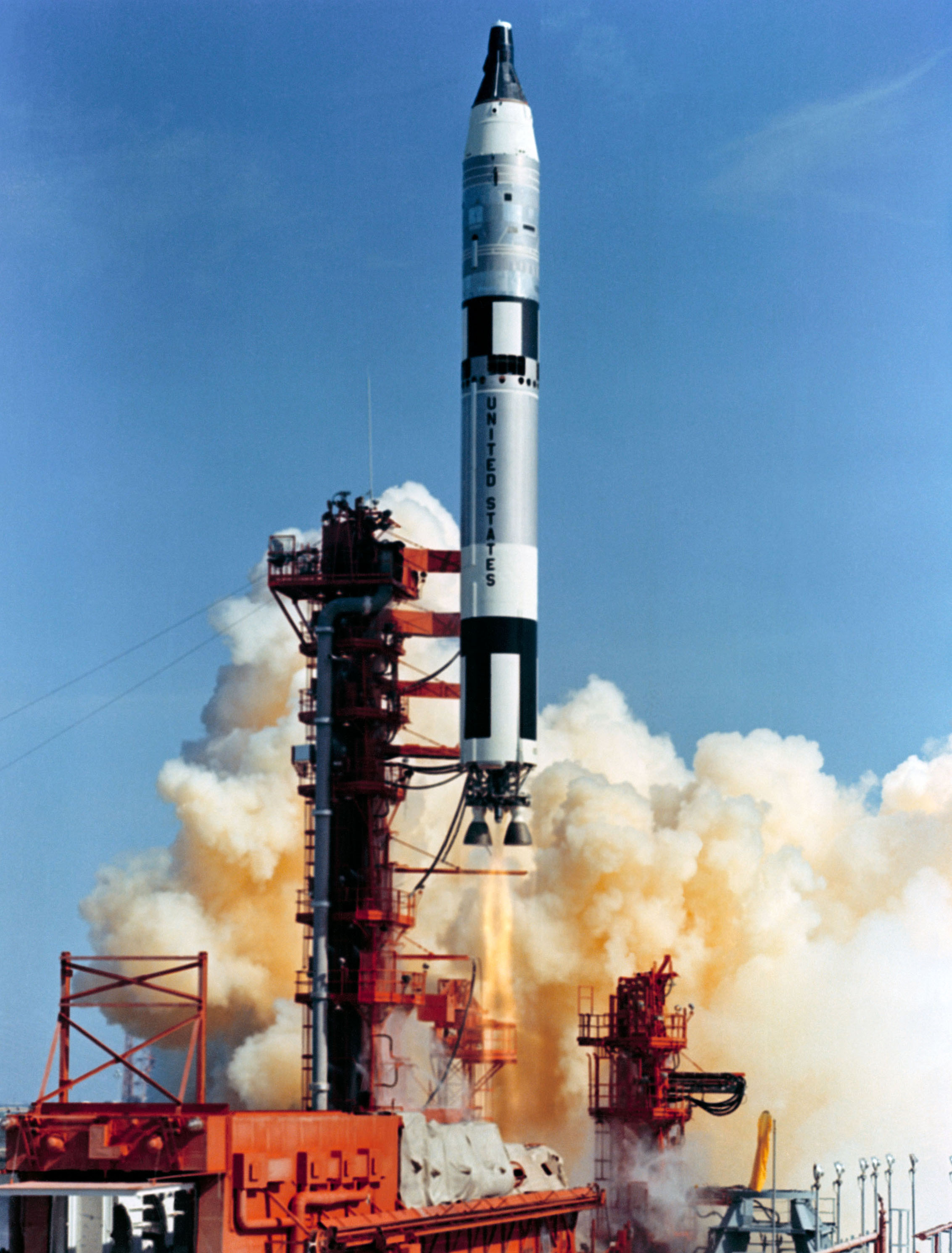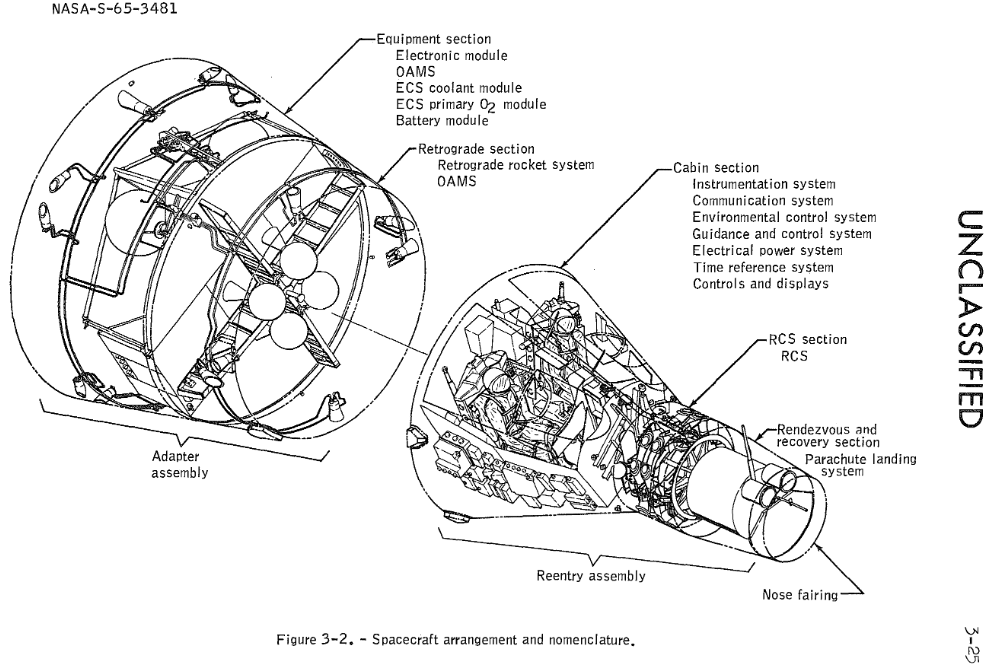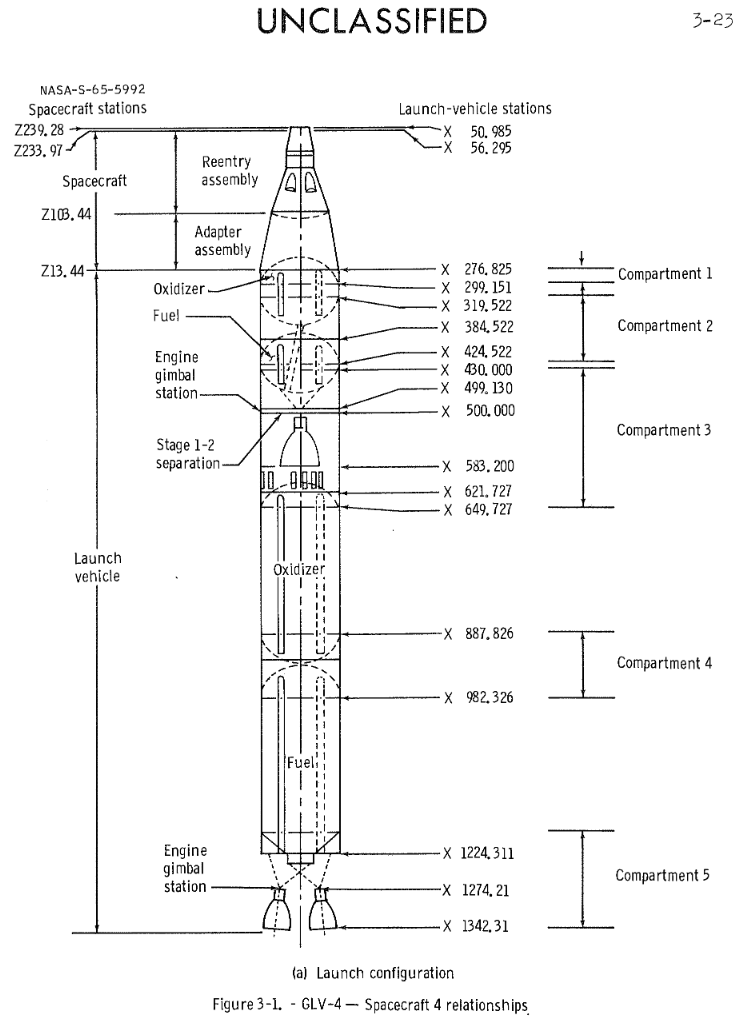
21 August 1965: At 9:00 a.m., Eastern Standard Time (13:59:59.518 UTC), Gemini V lifted off from Launch Complex 19 at Cape Kennedy, Florida. On board the spacecraft were L. Gordon Cooper, Command Pilot, and Charles (“Pete”) Conrad, Jr. The purpose of the mission was to demonstrate manned orbital flight for a period of 8 days. During the launch, the crew experienced a maximum acceleration of 7.6 g.
Five minutes, 56.91 seconds after liftoff, the Gemini spacecraft was placed in a 87.4 × 188.9 nautical mile elliptical orbit with a velocity of 25,805 feet/second, inclined from Earth’s axis by 32.59°, orbiting once every 89.59 minutes. At 56:00 ground elapsed time (g.e.t.), the crew performed an orbital maneuver which increased the minimum orbital altitude (perigee) to 92 nautical miles. The orbital period increased very slightly to 89.68 minutes.
The heater for the liquid oxygen supply of one of the two fuel cells failed at 25:51 g.e.t. The gaseous oxygen pressure began to decline from 853 psi to 70 over the next four hours. The crew powered down he spacecraft until it could be determined that the fuel cells could provide sufficient electrical power to continue the mission. Power was restored slowly over ten orbits.
During the third day, the crew practiced orbital maneuvers for upcoming Agena rendezvous and docking missions. 16 of 17 planned experiments were carried out over the course of the mission.
Reentery deceleration was 7.1 g. The actual landing point was 89 nautical miles short of predicted, at N. 29° 47′, W. 69° 45′. Total duration of the Gemini V mission was 190:55:17. The spacecraft and crew were recovered by the Essex-class aircraft carrier USS Lake Champlain (CVS -39).

The two-man Gemini spacecraft was built by the McDonnell Aircraft Corporation of St. Louis, the same company that built the earlier Mercury space capsule. The spacecraft consisted of a reentry module and an adapter section. It had an overall length of 19 feet (5.791 meters) and a diameter of 10 feet (3.048 meters) at the base of the adapter section. The reentry module was 11 feet (3.353 meters) long with a diameter of 7.5 feet (2.347 meters). The weight of the Gemini varied from ship to ship. At launch. Gemini Spacecraft 5 weighed 7,947.17 pounds (3,604.78 kilograms). At touchdown, after the parachute was jettisoned, it weighed 4,244.75 pounds (1,925.39 kilograms).

The Titan II GLV was a “man-rated” variant of the Martin SM-68B intercontinental ballistic missile. It was assembled at Martin’s Middle River, Maryland plant so as not to interfere with the production of the ICBM at Denver, Colorado. Twelve GLVs were ordered by the Air Force for the Gemini Program.
The Titan II GLV was a two-stage, liquid-fueled rocket. The first stage was 63 feet (19.202 meters) long with a diameter of 10 feet (3.048 meters). The second stage was 27 feet (8.230 meters) long, with the same diameter. The 1st stage was powered by an Aerojet Engineering Corporation LR-87-7 engine which combined two combustion chambers and exhaust nozzles with a single turbopump unit. The engine was fueled by a hypergolic combination of hydrazine and nitrogen tetroxide. Ignition occurred spontaneously as the two components were combined in the combustion chambers. The LR-87-7 produced 430,000 pounds of thrust. It was not throttled and could not be shut down and restarted. The 2nd stage used an Aerojet LR-91 engine which produced 100,000 pounds of thrust.
The Gemini 5/Titan II GLV-5 combination had a total height of 109 feet (33.223 meters) and weighed 344,685 pounds (156,346 kilograms) when at first stage ignition.
© 2019, Bryan R. Swopes